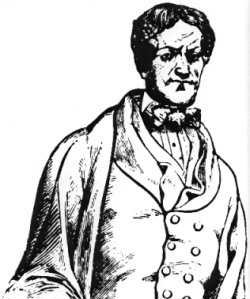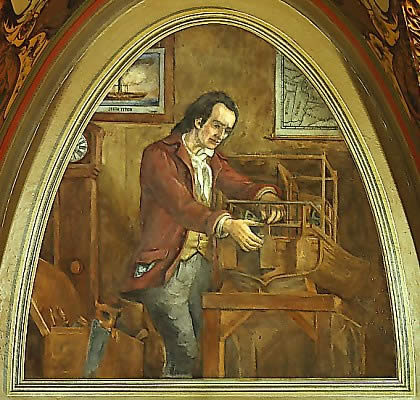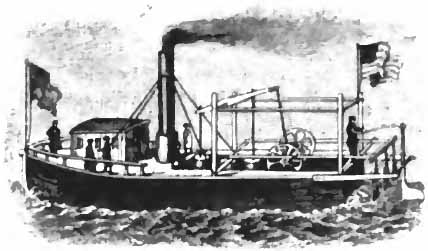<Back to Index>
- Inventor John Fitch, 1743
- Fashion Designer Christian Dior, 1905
- King of France Charles V, 1338
PAGE SPONSOR



John Fitch (January 21, 1743 – July 2, 1798) was an American inventor, clockmaker, and silversmith who, in 1787, built the first recorded steam powered boat in the United States. Two decades later, Robert Fulton was able to make steamboats profitable.
Fitch was born in Windsor, Connecticut, on January 21, 1743 , on a farm that is part of present day South Windsor, Connecticut. He received little formal schooling and eventually apprenticed himself to a clockmaker, during which time Fitch was not allowed to learn or even observe watchmaking (he later taught himself how to repair clocks and watches). Following this apprenticeship in Hartford, he opened an unsuccessful brass foundry in East Windsor, Connecticut, and then a brass and silversmith business in Trenton, New Jersey, which succeeded for eight years but was destroyed by British troops during the American Revolution.
He
served briefly during the Revolution, mostly as a gunsmith working for
the New Jersey militia; he left his unit after a dispute over a
promotion but continued his work repairing and refitting arms in
Trenton. In the fall of 1777, Fitch provided beer and tobacco to the
Continental Army in Philadelphia. During the following winter and
spring, he provided beer, rum, and other supplies to troops at Valley
Forge. In 1780, he began work as a surveyor in Kentucky where he
recorded a land claim of 1,600 acres (6.5 km2) for himself. In the spring of 1782, surveying in the Northwest Territory he was captured by Indians and turned over to the British who eventually released him. By 1785, Fitch was done with surveying and settled in Bucks County, Pennsylvania, where
he began working on his ideas for a steam powered boat. Unable to raise
funds from the Continental Congress, he persuaded various state
legislatures to award him a 14-year monopoly for steamboat traffic on
their inland waterways. With these monopolies he was able to secure
funding from businessmen and professional citizens in Philadelphia.
Fitch had seen a drawing of an early British Newcomen steam engine in an encyclopedia, but Newcomen engines were huge structures designed to pump water out of mines. He had somehow heard about the smaller and more efficient steam engine developed by James Watt in Scotland in the late 1770s, but there was not a single Watt engine in America at that time, nor would there be for many years (Fulton's exported model in his 1807 steamboat, Clermont, would be one of the first) because Britain would not allow the export of new technology to its former colony. Therefore, Fitch attempted to design his own version of a steam engine. He moved to Philadelphia and engaged the clockmaker and inventor Henry Voigt, to help him build a working model and place it on a boat.
The first successful trial run of his steamboat "Perseverance" was made on the Delaware River on August 22, 1787, in the presence of delegates from the Constitutional Convention.
It was propelled by a bank of oars on either side of the boat. During
the next few years, Fitch and Voigt worked to develop better designs,
and in June 1790 launched a 60 foot (18 m) boat powered by a steam
engine driving several stern mounted oars. These oars paddled in a
manner similar to the motion of a swimming duck's feet. With this boat
he carried up to thirty paying passengers on numerous round trip
voyages between Philadelphia and Burlington, New Jersey during
the summer of 1790. Estimates of miles traveled that summer range from
1,300 to 3,000 miles, and Fitch claimed that the boat often went for
500 miles without mechanical problems.
Fitch was granted a patent on August 26, 1791, after a battle with James Rumsey, who had also invented a steam powered boat. Unfortunately, the newly created Patent Commission did not award the broad monopoly patent that Fitch had asked for, but a patent of the modern kind, for the new design of Fitch's steamboat. It also awarded steam engine related patents dated that same day to Rumsey, Nathan Read, and John Stevens. The loss of a monopoly due to these same day patent awards led many of Fitch's investors to leave his company. While his boats were mechanically successful, Fitch no longer had the financial resources to carry on.
Fitch's idea would be turned profitable by Robert Fulton two
decades later. Though Fulton was able to obtain a monopoly in the state
of New York, because of the powerful influence of his partner Robert Livingston,
he was unable to gain a US patent largely because the originality of
Fulton's designs could not be demonstrated; it didn't help that because
an original member of Fitch's company, William Thornton, had become
head of the newly created Patent Office and made the application
process even more difficult for Fulton. Fitch had also received a
patent in 1791 from France,
and in 1793, having given up hope of building a steamboat in the United
States, left for France, where an American investor, Aaron Vail, had
promised to help him build a boat there. As his luck would have it,
Fitch arrived just as the Reign of Terror was
beginning, and his plans had to be abandoned. He made his way to London
to make an attempt there, but that also failed. He returned to the
United States in 1794 and made a few more tries to build a steamboat.
Failing once again, he moved to Bardstown, Kentucky, in 1797, where he
hoped to sell some of the lands he had acquired there in the early
1780s and use the proceeds to build a steamboat for use on the Ohio or
Mississippi River. He arrived to find settlers occupying his
properties, with the result that legal disputes occupied him until his
death in 1798.
While living in Kentucky, Fitch continued to work on steam engine ideas. He built two models, one of which was lost in a fire in Bardstown. The other was found in the attic of his daughter's house in Ohio in 1849. The model still exists at the Ohio Historical Society Museum in Columbus. In the 1950s, experts from the Smithsonian Museum examined it and concluded that it was "the prototype of a practical land operating steam engine," meant to operate on tracks – in other words, a steam locomotive.
In 1802, the Englishman Richard Trevithick invented a full size steam locomotive that, in 1804, hauled the world's first locomotive hauled railway train, and within a short time the British invention led to the development of actual railways. Americans began importing English locomotives and copying them. His legal dispute over state monopoly rights with fellow steamboat inventor James Rumsey and others helped bring about the enactment of the first Patent Act of 1790. He is mentioned in the personal letters of several historical figures including George Washington, Benjamin Franklin, Thomas Jefferson, and James Madison.
An 1876 fresco in the US Capitol by Constantino Brumidi depicts
Fitch working on one of his steamboat models. The John Fitch Steamboat
Museum is currently being built (as of winter 2010) in Warminster,
Pennsylvania. A memorial to Fitch stands in Bardstown, Kentucky's Courthouse Square, complete with a replica of his first steamboat. A small Fitch Monument stands in Warminster Township, Pennsylvania, at
the corner of York and Street roads, near the spot where he first
conceived of a steam-driven vehicle. John Fitch High School was built
on Bloomfield Avenue in Windsor, Connecticut, in
the 1934. It became an elementary school in the 1950s. The building was
converted to elderly housing in the 1990s, but its facade still bears
Fitch's name and likeness carved in stone. It is listed on the National Register of Historic Places. There is a John Fitch Elementary School in Levittown, Pennsylvania. The state of Connecticut has designated U.S. Route 5 through South Windsor and East Windsor as the "John Fitch Boulevard". The four lane highway runs parallel to, and often within sight of, the Connecticut River. The state of New Jersey designated a section of Rt. 29 in Trenton, along the Delaware River, the John Fitch Parkway. Fitch's journal and memoirs were published many years later as The Autobiography of John Fitch.
Though told with the biases of a bitter and disappointed man, they are
a vivid and moving picture of his times and unhappy life.
